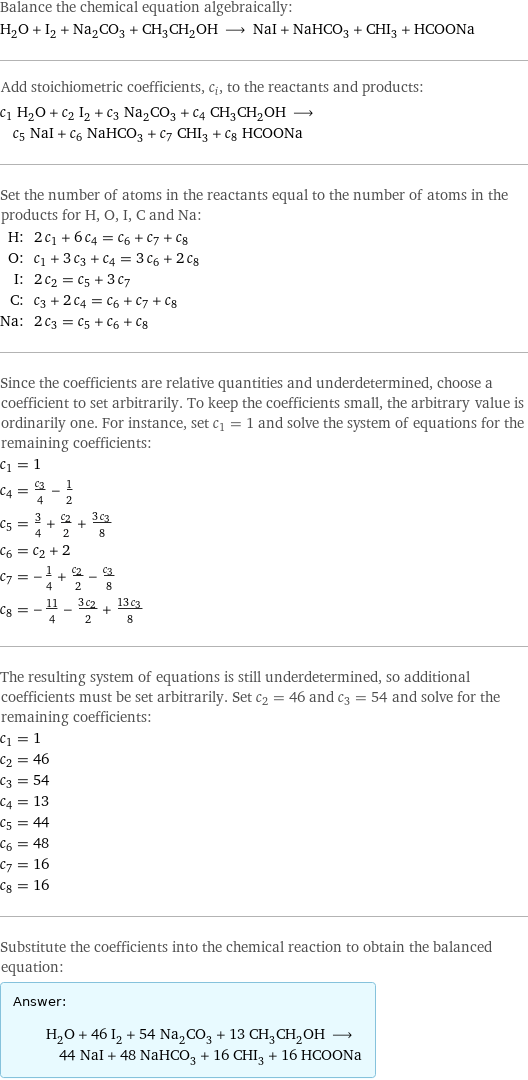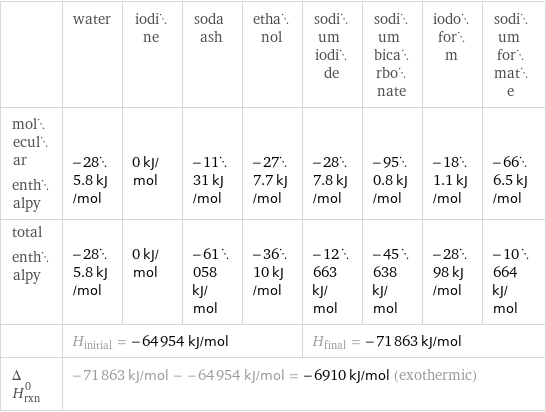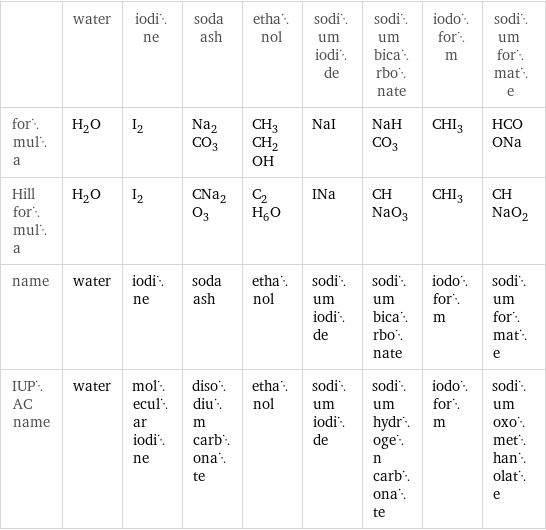Input interpretation

H_2O water + I_2 iodine + Na_2CO_3 soda ash + CH_3CH_2OH ethanol ⟶ NaI sodium iodide + NaHCO_3 sodium bicarbonate + CHI_3 iodoform + HCOONa sodium formate
Balanced equation

Balance the chemical equation algebraically: H_2O + I_2 + Na_2CO_3 + CH_3CH_2OH ⟶ NaI + NaHCO_3 + CHI_3 + HCOONa Add stoichiometric coefficients, c_i, to the reactants and products: c_1 H_2O + c_2 I_2 + c_3 Na_2CO_3 + c_4 CH_3CH_2OH ⟶ c_5 NaI + c_6 NaHCO_3 + c_7 CHI_3 + c_8 HCOONa Set the number of atoms in the reactants equal to the number of atoms in the products for H, O, I, C and Na: H: | 2 c_1 + 6 c_4 = c_6 + c_7 + c_8 O: | c_1 + 3 c_3 + c_4 = 3 c_6 + 2 c_8 I: | 2 c_2 = c_5 + 3 c_7 C: | c_3 + 2 c_4 = c_6 + c_7 + c_8 Na: | 2 c_3 = c_5 + c_6 + c_8 Since the coefficients are relative quantities and underdetermined, choose a coefficient to set arbitrarily. To keep the coefficients small, the arbitrary value is ordinarily one. For instance, set c_1 = 1 and solve the system of equations for the remaining coefficients: c_1 = 1 c_4 = c_3/4 - 1/2 c_5 = 3/4 + c_2/2 + (3 c_3)/8 c_6 = c_2 + 2 c_7 = -1/4 + c_2/2 - c_3/8 c_8 = -11/4 - (3 c_2)/2 + (13 c_3)/8 The resulting system of equations is still underdetermined, so additional coefficients must be set arbitrarily. Set c_2 = 46 and c_3 = 54 and solve for the remaining coefficients: c_1 = 1 c_2 = 46 c_3 = 54 c_4 = 13 c_5 = 44 c_6 = 48 c_7 = 16 c_8 = 16 Substitute the coefficients into the chemical reaction to obtain the balanced equation: Answer: | | H_2O + 46 I_2 + 54 Na_2CO_3 + 13 CH_3CH_2OH ⟶ 44 NaI + 48 NaHCO_3 + 16 CHI_3 + 16 HCOONa
Structures

+ + + ⟶ + + +
Names

water + iodine + soda ash + ethanol ⟶ sodium iodide + sodium bicarbonate + iodoform + sodium formate
Reaction thermodynamics
Enthalpy

| water | iodine | soda ash | ethanol | sodium iodide | sodium bicarbonate | iodoform | sodium formate molecular enthalpy | -285.8 kJ/mol | 0 kJ/mol | -1131 kJ/mol | -277.7 kJ/mol | -287.8 kJ/mol | -950.8 kJ/mol | -181.1 kJ/mol | -666.5 kJ/mol total enthalpy | -285.8 kJ/mol | 0 kJ/mol | -61058 kJ/mol | -3610 kJ/mol | -12663 kJ/mol | -45638 kJ/mol | -2898 kJ/mol | -10664 kJ/mol | H_initial = -64954 kJ/mol | | | | H_final = -71863 kJ/mol | | | ΔH_rxn^0 | -71863 kJ/mol - -64954 kJ/mol = -6910 kJ/mol (exothermic) | | | | | | |
Equilibrium constant
![Construct the equilibrium constant, K, expression for: H_2O + I_2 + Na_2CO_3 + CH_3CH_2OH ⟶ NaI + NaHCO_3 + CHI_3 + HCOONa Plan: • Balance the chemical equation. • Determine the stoichiometric numbers. • Assemble the activity expression for each chemical species. • Use the activity expressions to build the equilibrium constant expression. Write the balanced chemical equation: H_2O + 46 I_2 + 54 Na_2CO_3 + 13 CH_3CH_2OH ⟶ 44 NaI + 48 NaHCO_3 + 16 CHI_3 + 16 HCOONa Assign stoichiometric numbers, ν_i, using the stoichiometric coefficients, c_i, from the balanced chemical equation in the following manner: ν_i = -c_i for reactants and ν_i = c_i for products: chemical species | c_i | ν_i H_2O | 1 | -1 I_2 | 46 | -46 Na_2CO_3 | 54 | -54 CH_3CH_2OH | 13 | -13 NaI | 44 | 44 NaHCO_3 | 48 | 48 CHI_3 | 16 | 16 HCOONa | 16 | 16 Assemble the activity expressions accounting for the state of matter and ν_i: chemical species | c_i | ν_i | activity expression H_2O | 1 | -1 | ([H2O])^(-1) I_2 | 46 | -46 | ([I2])^(-46) Na_2CO_3 | 54 | -54 | ([Na2CO3])^(-54) CH_3CH_2OH | 13 | -13 | ([CH3CH2OH])^(-13) NaI | 44 | 44 | ([NaI])^44 NaHCO_3 | 48 | 48 | ([NaHCO3])^48 CHI_3 | 16 | 16 | ([CHI3])^16 HCOONa | 16 | 16 | ([HCOONa])^16 The equilibrium constant symbol in the concentration basis is: K_c Mulitply the activity expressions to arrive at the K_c expression: Answer: | | K_c = ([H2O])^(-1) ([I2])^(-46) ([Na2CO3])^(-54) ([CH3CH2OH])^(-13) ([NaI])^44 ([NaHCO3])^48 ([CHI3])^16 ([HCOONa])^16 = (([NaI])^44 ([NaHCO3])^48 ([CHI3])^16 ([HCOONa])^16)/([H2O] ([I2])^46 ([Na2CO3])^54 ([CH3CH2OH])^13)](../image_source/4ec7959acfc21734bdcddb79f5a0ea1d.png)
Construct the equilibrium constant, K, expression for: H_2O + I_2 + Na_2CO_3 + CH_3CH_2OH ⟶ NaI + NaHCO_3 + CHI_3 + HCOONa Plan: • Balance the chemical equation. • Determine the stoichiometric numbers. • Assemble the activity expression for each chemical species. • Use the activity expressions to build the equilibrium constant expression. Write the balanced chemical equation: H_2O + 46 I_2 + 54 Na_2CO_3 + 13 CH_3CH_2OH ⟶ 44 NaI + 48 NaHCO_3 + 16 CHI_3 + 16 HCOONa Assign stoichiometric numbers, ν_i, using the stoichiometric coefficients, c_i, from the balanced chemical equation in the following manner: ν_i = -c_i for reactants and ν_i = c_i for products: chemical species | c_i | ν_i H_2O | 1 | -1 I_2 | 46 | -46 Na_2CO_3 | 54 | -54 CH_3CH_2OH | 13 | -13 NaI | 44 | 44 NaHCO_3 | 48 | 48 CHI_3 | 16 | 16 HCOONa | 16 | 16 Assemble the activity expressions accounting for the state of matter and ν_i: chemical species | c_i | ν_i | activity expression H_2O | 1 | -1 | ([H2O])^(-1) I_2 | 46 | -46 | ([I2])^(-46) Na_2CO_3 | 54 | -54 | ([Na2CO3])^(-54) CH_3CH_2OH | 13 | -13 | ([CH3CH2OH])^(-13) NaI | 44 | 44 | ([NaI])^44 NaHCO_3 | 48 | 48 | ([NaHCO3])^48 CHI_3 | 16 | 16 | ([CHI3])^16 HCOONa | 16 | 16 | ([HCOONa])^16 The equilibrium constant symbol in the concentration basis is: K_c Mulitply the activity expressions to arrive at the K_c expression: Answer: | | K_c = ([H2O])^(-1) ([I2])^(-46) ([Na2CO3])^(-54) ([CH3CH2OH])^(-13) ([NaI])^44 ([NaHCO3])^48 ([CHI3])^16 ([HCOONa])^16 = (([NaI])^44 ([NaHCO3])^48 ([CHI3])^16 ([HCOONa])^16)/([H2O] ([I2])^46 ([Na2CO3])^54 ([CH3CH2OH])^13)
Rate of reaction
![Construct the rate of reaction expression for: H_2O + I_2 + Na_2CO_3 + CH_3CH_2OH ⟶ NaI + NaHCO_3 + CHI_3 + HCOONa Plan: • Balance the chemical equation. • Determine the stoichiometric numbers. • Assemble the rate term for each chemical species. • Write the rate of reaction expression. Write the balanced chemical equation: H_2O + 46 I_2 + 54 Na_2CO_3 + 13 CH_3CH_2OH ⟶ 44 NaI + 48 NaHCO_3 + 16 CHI_3 + 16 HCOONa Assign stoichiometric numbers, ν_i, using the stoichiometric coefficients, c_i, from the balanced chemical equation in the following manner: ν_i = -c_i for reactants and ν_i = c_i for products: chemical species | c_i | ν_i H_2O | 1 | -1 I_2 | 46 | -46 Na_2CO_3 | 54 | -54 CH_3CH_2OH | 13 | -13 NaI | 44 | 44 NaHCO_3 | 48 | 48 CHI_3 | 16 | 16 HCOONa | 16 | 16 The rate term for each chemical species, B_i, is 1/ν_i(Δ[B_i])/(Δt) where [B_i] is the amount concentration and t is time: chemical species | c_i | ν_i | rate term H_2O | 1 | -1 | -(Δ[H2O])/(Δt) I_2 | 46 | -46 | -1/46 (Δ[I2])/(Δt) Na_2CO_3 | 54 | -54 | -1/54 (Δ[Na2CO3])/(Δt) CH_3CH_2OH | 13 | -13 | -1/13 (Δ[CH3CH2OH])/(Δt) NaI | 44 | 44 | 1/44 (Δ[NaI])/(Δt) NaHCO_3 | 48 | 48 | 1/48 (Δ[NaHCO3])/(Δt) CHI_3 | 16 | 16 | 1/16 (Δ[CHI3])/(Δt) HCOONa | 16 | 16 | 1/16 (Δ[HCOONa])/(Δt) (for infinitesimal rate of change, replace Δ with d) Set the rate terms equal to each other to arrive at the rate expression: Answer: | | rate = -(Δ[H2O])/(Δt) = -1/46 (Δ[I2])/(Δt) = -1/54 (Δ[Na2CO3])/(Δt) = -1/13 (Δ[CH3CH2OH])/(Δt) = 1/44 (Δ[NaI])/(Δt) = 1/48 (Δ[NaHCO3])/(Δt) = 1/16 (Δ[CHI3])/(Δt) = 1/16 (Δ[HCOONa])/(Δt) (assuming constant volume and no accumulation of intermediates or side products)](../image_source/7416b3f41f634cf0b2d542ce2a227e5a.png)
Construct the rate of reaction expression for: H_2O + I_2 + Na_2CO_3 + CH_3CH_2OH ⟶ NaI + NaHCO_3 + CHI_3 + HCOONa Plan: • Balance the chemical equation. • Determine the stoichiometric numbers. • Assemble the rate term for each chemical species. • Write the rate of reaction expression. Write the balanced chemical equation: H_2O + 46 I_2 + 54 Na_2CO_3 + 13 CH_3CH_2OH ⟶ 44 NaI + 48 NaHCO_3 + 16 CHI_3 + 16 HCOONa Assign stoichiometric numbers, ν_i, using the stoichiometric coefficients, c_i, from the balanced chemical equation in the following manner: ν_i = -c_i for reactants and ν_i = c_i for products: chemical species | c_i | ν_i H_2O | 1 | -1 I_2 | 46 | -46 Na_2CO_3 | 54 | -54 CH_3CH_2OH | 13 | -13 NaI | 44 | 44 NaHCO_3 | 48 | 48 CHI_3 | 16 | 16 HCOONa | 16 | 16 The rate term for each chemical species, B_i, is 1/ν_i(Δ[B_i])/(Δt) where [B_i] is the amount concentration and t is time: chemical species | c_i | ν_i | rate term H_2O | 1 | -1 | -(Δ[H2O])/(Δt) I_2 | 46 | -46 | -1/46 (Δ[I2])/(Δt) Na_2CO_3 | 54 | -54 | -1/54 (Δ[Na2CO3])/(Δt) CH_3CH_2OH | 13 | -13 | -1/13 (Δ[CH3CH2OH])/(Δt) NaI | 44 | 44 | 1/44 (Δ[NaI])/(Δt) NaHCO_3 | 48 | 48 | 1/48 (Δ[NaHCO3])/(Δt) CHI_3 | 16 | 16 | 1/16 (Δ[CHI3])/(Δt) HCOONa | 16 | 16 | 1/16 (Δ[HCOONa])/(Δt) (for infinitesimal rate of change, replace Δ with d) Set the rate terms equal to each other to arrive at the rate expression: Answer: | | rate = -(Δ[H2O])/(Δt) = -1/46 (Δ[I2])/(Δt) = -1/54 (Δ[Na2CO3])/(Δt) = -1/13 (Δ[CH3CH2OH])/(Δt) = 1/44 (Δ[NaI])/(Δt) = 1/48 (Δ[NaHCO3])/(Δt) = 1/16 (Δ[CHI3])/(Δt) = 1/16 (Δ[HCOONa])/(Δt) (assuming constant volume and no accumulation of intermediates or side products)
Chemical names and formulas

| water | iodine | soda ash | ethanol | sodium iodide | sodium bicarbonate | iodoform | sodium formate formula | H_2O | I_2 | Na_2CO_3 | CH_3CH_2OH | NaI | NaHCO_3 | CHI_3 | HCOONa Hill formula | H_2O | I_2 | CNa_2O_3 | C_2H_6O | INa | CHNaO_3 | CHI_3 | CHNaO_2 name | water | iodine | soda ash | ethanol | sodium iodide | sodium bicarbonate | iodoform | sodium formate IUPAC name | water | molecular iodine | disodium carbonate | ethanol | sodium iodide | sodium hydrogen carbonate | iodoform | sodium oxomethanolate